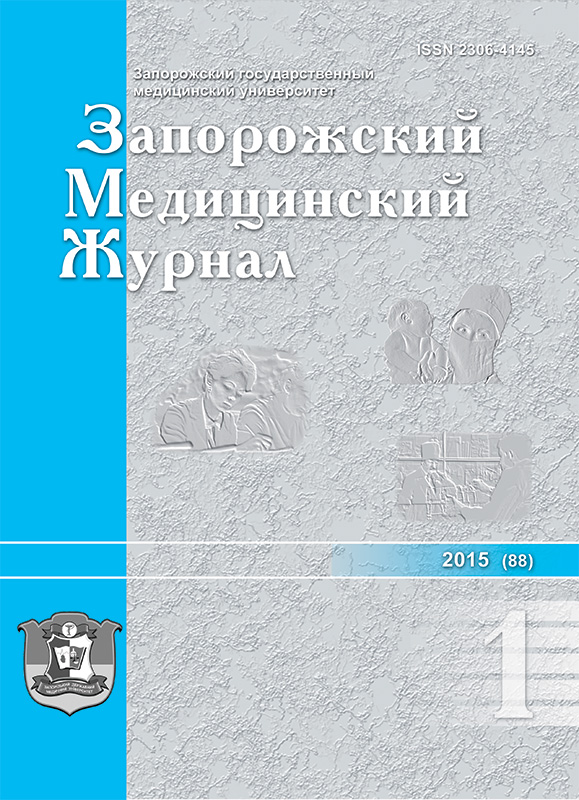Necrotizing enterocolitis. Roentgenologic, ultrasonic and laboratory methods of the examination, laparocentesis and laparoscopy
DOI:
https://doi.org/10.14739/2310-1210.2015.1.39878Keywords:
Necrotizing Enterocolitis, Newborn, Diagnostics X-ray Study, Ultrasonography and Laboratory Diagnosis, LaparoscopyAbstract
Aim. The current issues of NEC’s objective diagnostics in newborns are discussed in the article. Actuality of the necrotic enterocolitis (NEC) study is caused by the complexity of its diagnosis due to non-specific clinical symptoms. Necrotizing enterocolitis is the leading death cause in premature infants. The incidence of deaths due to NEC ranges from 28 to 54% and up to 100% in patients with the most severe disease course. Patients that have survived require prolonged hospitalization due to various complications including bowel obstruction, short bowel syndrome, cholestasis, psychomotor development delay.
Methods and results. Clinical symptoms were analyzed based on a literature review and the analysis of personal experience. Modern diagnostic methods (instrumental, radiological, laboratory) are offered in the article.
Conclusion. It is ascertained that they provide substantial assistance in NEC’s treatment and the ability to predict its course.
References
Ashkraft, K., & Kholder, T. (1996). Detskaya khirurgiya [Pediatric Surgery]. Saint Petersburg: Pit tal. [in Russian].
Gaimolenko, S., & Ruchkova, S. (2014). Nekroticheskij e`nterokolit novorozhdennykh: e`tiopatogenez, klassifikatsiya, klinika, diagnostika [Neonatal necrotizing enterocolitis: etiopathogenesis, classification, clinical picture]. Zabajkal'skij medicinskij zhurnal, 1, 13–22. [in Russian].
Gorbatyuk, O., Nedavnij, G., Stadnik, I., Martinyuk, T., Chekanov, Y., & Mart’ianova N. (2012) Vyznachennia likuvalnoi taktyky pry nekrotychnomu enterokoliti u novonarodzhenykh za danymy instrumentalnykh metodiv doslidzhennia [Determination of medical tacticsin newborns with NEC ACCORDING instrumental-diagnostic data]. Neonatologіya, khіrurgіya ta perinatal'na medicina, 2, 3(5), 54–58. [in Ukrainian].
Krasovskaja, T. V., Novozhilov, V. A., Ionushene, S. V., & Kikina E. I. (2004). Khirurgicheskie oslozhneniya nekroticheskogo e`nterokolita u novorozhdennykh detej: patogeneticheskoe obosnovanie putej profilaktiki [Surgical complications of necrotizing enterocolitis in newborn infants: a pathogenetic substantiation of ways to prevent]. Detskaya khirurgiya, 2, 15–19. [in Russian].
Karavaeva, S. (2002). Khirurgicheskoe lechenie nekroticheskogo e`nterokolita. (Avtoref. dis… dokt. med. nauk) [Surgical treatment of necrotizing enterocolitis. Dr. med. sci. diss.]. Saint Petersburg. [in Russian].
Krasovskaya, T., & Kobzeva, T. (2003). Khirurgiya novorozhdennykh: diagnostika i intensivnaya terapiya [Neonatal surgery: diagnosis and intensive care]. Moscow: Izdatel` Mokeev. [in Russian].
Lelyuk, V. G., & Lelyuk S. E`. 1997). Osnovnye principy gemodinamiki i ul`trazvukovogo issledovaniya sosudov [Basic principles of hemodynamics and vascular ultrasound]. Klinicheskoe rukovodstvo po ul'trazvukovoj diagnostike. Mit`kov V.V. (Ed.). Moscow: Vidar. [in Russian].
Sitko, L. A., Chernyshyov, A. K., Toropchennko, V. N., Mandrik, Т. М., Shlyakin, I. F. (2003). Kriterii tyazhesti i prognoza nekrotiziruyushchego e`nterokolita u novorozhdennykh [Criteria of severity and prognostication in necrotic enterocolitis in newborns]. Detskaya khirurgiya, 6, 468. [in Russian].
Cap, N. A., Kuznecov, N. N., Novoselova, O. V., Abolina, T. B., Bobkovskaya, E. E., Vershinina, G. A., & Chudakov, V. B. (2004). Khirurgicheskoe lechenie i prognozirovanie posleoperacionnogo perioda u novorozhdennykh s nekroticheskim e`nterokolitom [Surgical treatment and prediction of postoperative neonates with necrotizing enterocolitis]. Detskaya khirurgiya, 2, 13–15. [in Russian].
Bohnhorst, B. (2013). Usefulness of abdominal ultrasound in diagnosing necrotising enterocolitis. Archives of Disease in Childhood - Fetal and Neonatal Edition, 98(5), 445–450. doi: 10.1136/archdischild-2012-302848.
Dilli, D., Suna Oguz, S., Erol, L., Ozkan-Ulu, H., Dumanli, H., & Dilmen, U. (2011). Does abdominal sonography provide additional information over abdominal plain radiography for diagnosis of necrotizing enterocolitis in neonates. Pediatric Surg Int., 27(3), 321–327. doi: 10.1007/s00383-010-2737-8.
Gordon, P., Christensen, R., & Weitkamp, G. (2012). Mapping the New World of Necrotizing Enterocolitis (NEC). Review And Opinion EJ Neonatol Res., 2(4), 145–172.
Maheshwari, A., Corbin, L., & Schelonka, R. (2011). Neonatal necrotizing enterocolitis. Research And Reports In Neonatology, 1, 39–53.
Patel, B., & Shah, J. (2012). Necrotizing Enterocolitis in Very Low Birth Weight Infants: A Systemic Review. Gastroenterology., 10, 562–594. doi: 10.5402/2012/562594.
Raval, M., Hall, N., Pierro, A., & Moss, R. (2013). Evidence-based prevention and surgical treatment of necrotizing enterocolitis-A review of randomized controlled trials. Seminars In Pediatric Surgery, 22(2), 117–121. doi:10.1053/j.sempedsurg.2013.01.009.
Travadi, J., Patole, S., & Gardiner, K. (2003). Pneumatosis coli, a benign form of necrotising enterocolitis. Indian Pediatr., 40(4), 349–351.
Downloads
How to Cite
Issue
Section
License
Authors who publish with this journal agree to the following terms:
Authors retain copyright and grant the journal right of first publication with the work simultaneously licensed under a Creative Commons Attribution License that allows others to share the work with an acknowledgement of the work's authorship and initial publication in this journal. 

